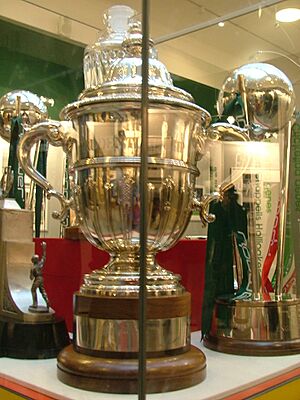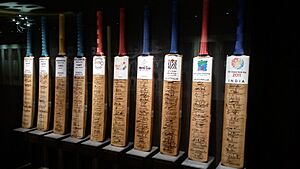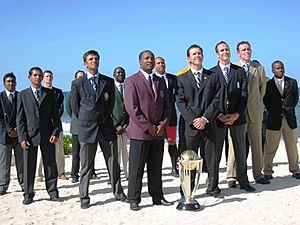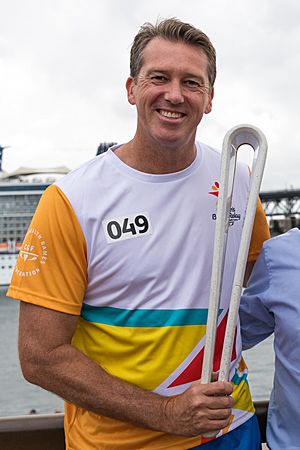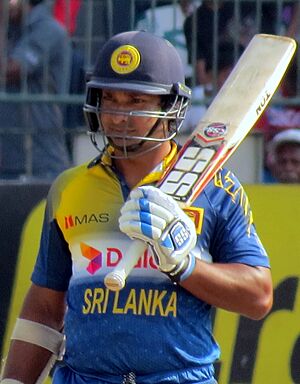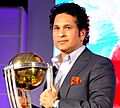Cricket World Cup facts for kids
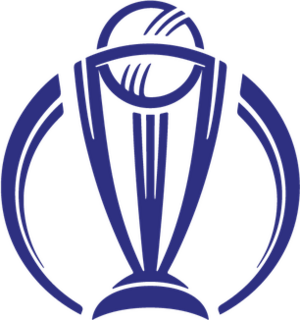 |
|
| Administrator | International Cricket Council |
|---|---|
| Format | One Day International |
| First edition |
|
| Latest edition |
|
| Next edition |
|
| Tournament format | see below |
| Number of teams | 14 |
| Current champion | |
| Most successful | |
| Most runs | |
| Most wickets | |
The ICC Men's Cricket World Cup is a huge international cricket tournament. It happens every four years and is organized by the International Cricket Council (ICC). Teams play a special type of cricket called One Day International (ODI), where each team bats for a set number of overs. It's one of the most-watched sports events in the world!
The first Cricket World Cup was held in England in June 1975. Before this, the first ODI cricket match had only been played four years earlier. Interestingly, a separate Women's Cricket World Cup took place two years before the men's tournament.
The first three World Cups were all held in England. Since the 1987 tournament, different countries have shared the hosting duties. So far, 14 ICC member countries have hosted at least one match.
To play in the World Cup, teams first go through a qualification phase. This takes about three years. In the main tournament, 10 teams, including the host nation, compete for the title. Games are played in the host country over about a month. For the 2027 World Cup, the plan is to have 14 teams in the final competition.
So far, 20 different teams have played in the 13 World Cups. In the most recent tournament in 2023, 10 teams competed. Australia has won the World Cup six times, which is more than any other team. India and West Indies have each won twice. Pakistan, Sri Lanka, and England have each won once. The best a non-full-member team has done is when Kenya reached the semi-finals in the 2003 tournament.
Australia are the current champions, having won the 2023 World Cup in India. The next World Cup in 2027 will be held in South Africa, Zimbabwe, and Namibia.
Contents
History of the Cricket World Cup
The very first international cricket match was played between Canada and the United States in 1844. However, the first official Test match was in 1877 between Australia and England. These two teams often played for The Ashes. South Africa joined Test cricket in 1889.
Cricket was even an Olympic sport once, at the 1900 Paris Games. Great Britain won the gold medal there. This was the only time cricket has been in the Summer Olympics.
The first time more than two international teams played together was in 1912. This was a Test cricket tournament in England with England, Australia, and South Africa. It wasn't very successful because of bad weather and low attendance. After that, international Test cricket was mostly played as two teams facing each other.
More countries started playing Test cricket over time. West Indies joined in 1928, New Zealand in 1930, India in 1932, and Pakistan in 1952. But international cricket was still mainly long Test matches.
In the early 1960s, a shorter version of cricket, lasting just one day, became popular in England. The first One-Day International (ODI) match happened in 1971. It was played between England and Australia in Melbourne to make up for a rain-stopped Test match. This new, shorter game was a big hit. Because of its popularity, the ICC decided to create a Cricket World Cup.
Early World Cups (1975–1983)
England hosted the first Cricket World Cup in 1975. At that time, England was the only country ready to host such a big event. The first three tournaments were called the Prudential Cup because of their sponsor. Matches had 60 overs per team and were played during the day. Players wore traditional white uniforms and used red cricket balls.
Eight teams played in the first tournament: Australia, England, India, New Zealand, Pakistan, and West Indies (the six Test nations). Sri Lanka and a team from East Africa also played. South Africa was not allowed to play because of apartheid. The West Indies team won the first tournament, beating Australia in the final.
The 1979 World Cup introduced the ICC Trophy competition. This helped non-Test playing teams qualify for the World Cup. Sri Lanka and Canada qualified that year. The West Indies won again, beating England in the final. After this, the International Cricket Conference decided the World Cup would happen every four years.
The 1983 event was also in England. By then, Sri Lanka had become a Test-playing nation, and Zimbabwe qualified through the ICC Trophy. A special "fielding circle" was added, 30 yards from the stumps. Four fielders had to stay inside it. Teams played each other twice before the knockout rounds. India became champions, surprisingly beating the West Indies in the final.
New Champions Emerge (1987–1996)
India and Pakistan hosted the 1987 tournament together. This was the first time it was held outside England. Games were shortened from 60 to 50 overs per team, which is still the standard today. This was because of shorter daylight hours in the Indian subcontinent. Australia won the championship, beating England by just 7 runs in a very close final.
The 1992 World Cup was held in Australia and New Zealand. Many new things were introduced, like colored uniforms, white balls, and day/night matches. The South African team played for the first time after the end of apartheid. Pakistan had a tough start but ended up winning the tournament, beating England in the final.
The 1996 championship was again in the Indian subcontinent, with Sri Lanka also hosting some matches. Sri Lanka won their first championship, beating Australia in the final in Lahore.
Australia's Winning Streak (1999–2007)
In 1999, the tournament was hosted by England, with some matches in Scotland, Ireland, Wales, and the Netherlands. Twelve teams competed. Australia made it to the final after a very close semi-final match against South Africa. In the final, Australia easily beat Pakistan to win the cup.
South Africa, Zimbabwe, and Kenya hosted the 2003 World Cup. The number of teams grew to fourteen. Kenya did very well, reaching the semi-finals. This was the best result ever for a team that wasn't a full ICC member. In the final, Australia scored a huge 359 runs, the highest score in a final, and defeated India.
In 2007, the tournament was in the West Indies and had sixteen teams. Australia beat Sri Lanka in the final. This win meant Australia had won three World Cups in a row and had not lost a World Cup match in 29 games!
Host Nations Triumph (2011–2019)
India, Sri Lanka, and Bangladesh hosted the 2011 World Cup together. The number of teams was reduced to fourteen. Australia's amazing 35-match unbeaten streak in the World Cup ended in this tournament. India won their second World Cup title by beating Sri Lanka in the final in Mumbai. India became the first country to win the World Cup on their home ground. This was also the first time two Asian countries played each other in a World Cup Final.
Australia and New Zealand jointly hosted the 2015 World Cup. Fourteen teams participated. New Zealand reached their first World Cup final by beating South Africa in a thrilling semi-final. Australia then defeated New Zealand in the final in Melbourne to win their fifth World Cup.
The 2019 World Cup was hosted by England and Wales. The number of teams was reduced to 10. New Zealand beat India in a semi-final that went into an extra day because of rain. England defeated the defending champions, Australia, in the other semi-final. Neither England nor New Zealand had ever won the World Cup before. In the final, the scores were tied after 50 overs, and then tied again after a special "super over." England won because they had hit more boundaries (fours and sixes) during the match.
Australia Wins Again (2023)
The 2023 Cricket World Cup was hosted by India. Ten teams played, including the Netherlands, who returned after 12 years. The West Indies, who had won the first two World Cups, did not qualify for the first time ever. India played incredibly well in the group stage, winning all their matches. They then beat New Zealand to reach the final. Australia lost two games early on but then won eight games in a row, including beating South Africa in the semi-finals. Afghanistan had their best World Cup ever, winning four games, including against England and Pakistan. In the final, Australia defeated the unbeaten Indian team to win their record-breaking sixth World Cup title.
The next World Cup in 2027 will be hosted by South Africa, Zimbabwe, and Namibia.
How the Tournament Works
Qualification Process
From the first World Cup in 1975 up to the 2019 World Cup, most teams got into the tournament automatically. This was usually because they were "Full Members" of the ICC or had a high ranking.
Since the second World Cup in 1979, a few other teams qualified through special tournaments. The main qualifying tournament was first called the ICC Trophy. Later, this process grew to include more pre-qualifying tournaments. For the 2011 World Cup, the "ICC World Cricket League" was created to give "Associate" and "Affiliate" members of the ICC more chances to qualify.
Starting from the 2023 World Cup, only the host nation(s) get in automatically. All other countries have to play in a series of leagues to earn their spot. Teams can move up or down between different divisions based on their performance.
Tournament Format Changes
The way the Cricket World Cup is played has changed a lot over the years. The first four tournaments had eight teams, split into two groups of four. The top two teams from each group went to the semi-finals, and the winners played in the final.
When South Africa returned in 1992, nine teams played each other once. The top four teams then went to the semi-finals. The tournament got even bigger in 1996, with two groups of six teams. The top four from each group moved on to quarter-finals and then semi-finals.
A different format was used for the 1999 and 2003 World Cups. Teams were divided into two pools. The top three from each pool went into a "Super 6" stage. In this stage, teams played the three teams from the other group. They also carried over points from their earlier matches against teams that also qualified. The top four teams from the "Super 6" went to the semi-finals.
The 2007 World Cup had 16 teams in four groups of four. Teams played everyone in their group. The top two from each group moved to the "Super 8" round. In the "Super 8", teams played the six teams from the other groups. Points from earlier matches against other qualifying teams were carried over. The top four teams from the "Super 8" went to the semi-finals.
The 2011 and 2015 World Cups had two groups of seven teams. The top four from each group went to the knockout stage, which included quarter-finals, semi-finals, and the final.
In the 2019 and 2023 tournaments, only 10 teams played. Each team played every other team once in a round-robin style. Then, the top four teams went to the semi-finals. This was similar to the 1992 World Cup format. The 2027 and 2031 World Cups will have 14 teams, using a format similar to the 2003 edition.
| Summary of tournament formats | ||||||
|---|---|---|---|---|---|---|
| Ed. | Year | Host(s) | Teams | Matches | Preliminary stage | Final stage |
| 1 | 1975 | 8 | 15 | 2 groups of 4 teams: 12 matches | Knock-out of 4 teams (group winners and runners-up): 3 matches | |
| 2 | 1979 | |||||
| 3 | 1983 | 27 | 2 groups of 4 teams: 24 matches | |||
| 4 | 1987 | |||||
| 5 | 1992 | 9 | 39 | 1 group of 9 teams: 36 matches | Knock-out of 4 teams (top 4 in group): 3 matches | |
| 6 | 1996 | 12 | 37 | 2 groups of 6 teams: 30 matches | Knock-out of 8 teams (top 4 in each group): 7 matches | |
| 7 | 1999 | 42 | 2 groups of 6 teams: 30 matches | Super Sixes (top 3 in each group): 9 matches Knock-out of 4 teams (top 4 in Super Sixes): 3 matches |
||
| 8 | 2003 | 14 | 54 | 2 groups of 7 teams: 42 matches | ||
| 9 | 2007 | 16 | 51 | 4 groups of 4 teams: 24 matches | Super Eights (top 2 in each group): 24 matches Knock-out of 4 teams (top 4 in Super Eights): 3 matches |
|
| 10 | 2011 | 14 | 49 | 2 groups of 7 teams: 42 matches | Knock-out of 8 teams (top 4 in each group): 7 matches | |
| 11 | 2015 | |||||
| 12 | 2019 | 10 | 48 | 1 group of 10 teams: 45 matches | Knock-out of 4 teams (top 4 in group): 3 matches | |
| 13 | 2023 | |||||
| 14 | 2027 | 14 | 54 | 2 groups of 7 teams: 42 matches | Super Sixes (top 3 in each group): 9 matches Knock-out of 4 teams (top 4 in Super Sixes): 3 matches |
|
| 15 | 2031 | |||||
The World Cup Trophy
The ICC Cricket World Cup Trophy is given to the winning team. The trophy we see today was first made for the 1999 championships. Before that, a new trophy was designed for each World Cup. For example, the "Prudential Cup" trophies were used for the first three tournaments.
The current trophy is made of silver and gold. It has a golden globe held up by three silver columns. These columns look like stumps and bails, which are important parts of cricket. They represent the three main skills in cricket: batting, bowling, and fielding. The globe itself looks like a cricket ball.
The trophy is about 60 centimeters (2 feet) tall and weighs around 11 kilograms (24 pounds). The names of all the past winners are carved into the base of the trophy. The ICC keeps the original trophy. The winning team gets a copy of the trophy, which is exactly the same except for the names engraved on it.
World Cup on TV and Online
The Cricket World Cup is one of the most-watched sports events in the world. Each tournament gets more and more attention as One-Day International cricket becomes more popular. The 2011 World Cup was shown in over 200 countries to more than 2.2 billion viewers!
The rights to show the World Cup on TV, especially for the 2011 and 2015 tournaments, were sold for over 1.1 billion US dollars. Sponsorship rights brought in another 500 million US dollars. The ICC said that the 2019 World Cup had 1.6 billion viewers and 4.6 billion views of digital videos. The most-watched match in 2019 was between India and Pakistan, with over 300 million people watching live.
Who Hosts the World Cup?
The International Cricket Council's executive committee chooses the host countries for the World Cup. They look at bids from nations that want to hold the tournament.
England hosted the first three World Cups. The ICC chose England because it had the resources to organize the first big event. India wanted to host the third World Cup, but most ICC members preferred England. This was because England had longer daylight hours in June, which meant matches could be finished in one day. The 1987 Cricket World Cup was the first to be held outside England, in India and Pakistan.
Many tournaments have been co-hosted by countries in the same region. For example, South Asia hosted in 1987, 1996, and 2011. Australia and New Zealand hosted together in 1992 and 2015. Southern Africa hosted in 2003, and the West Indies hosted in 2007.
In November 2021, the ICC announced the hosts for its major events from 2024 to 2031. This included the 50-over World Cup, T20 World Cup, and Champions Trophy. The hosts were chosen through a bidding process.
World Cup Winners and Records
Tournament Results
| Ed. | Year | Hosts | Final Venue | Final | No. of teams |
||
|---|---|---|---|---|---|---|---|
| Champions | Result | Runners-up | |||||
| 1 | 1975 | Lord's, London | 291/8 (60 overs) |
West Indies won by 17 runs (scorecard) |
274 all out (58.4 overs) |
8 | |
| 2 | 1979 | Lord's, London | 286/9 (60 overs) |
West Indies won by 92 runs (scorecard) |
194 all out (51 overs) |
8 | |
| 3 | 1983 | Lord's, London | 183 all out (54.4 overs) |
India won by 43 runs (scorecard) |
140 all out (52 overs) |
8 | |
| 4 | 1987 | Eden Gardens, Kolkata | 253/5 (50 overs) |
Australia won by 7 runs (scorecard) |
246/8 (50 overs) |
8 | |
| 5 | 1992 | Melbourne Cricket Ground, Melbourne | 249/6 (50 overs) |
Pakistan won by 22 runs (scorecard) |
227 all out (49.2 overs) |
9 | |
| 6 | 1996 | Gaddafi Stadium, Lahore | 245/3 (46.2 overs) |
Sri Lanka won by 7 wickets (scorecard) |
241/7 (50 overs) |
12 | |
| 7 | 1999 | Lord's, London | 133/2 (20.1 overs) |
Australia won by 8 wickets (scorecard) |
132 all out (39 overs) |
12 | |
| 8 | 2003 | Wanderers Stadium, Johannesburg | 359/2 (50 overs) |
Australia won by 125 runs (scorecard) |
234 all out (39.2 overs) |
14 | |
| 9 | 2007 | Kensington Oval, Bridgetown | 281/4 (38 overs) |
Australia won by 53 runs (D/L) (scorecard) |
215/8 (36 overs) |
16 | |
| 10 | 2011 | Wankhede Stadium, Mumbai | 277/4 (48.2 overs) |
India won by 6 wickets (scorecard) |
274/6 (50 overs) |
14 | |
| 11 | 2015 | Melbourne Cricket Ground, Melbourne | 186/3 (33.1 overs) |
Australia won by 7 wickets (scorecard) |
183 all out (45 overs) |
14 | |
| 12 | 2019 | Lord's, London | 241 all out (50 overs) 15/0 (super over) 24 fours, 2 sixes |
Match tied (England won on boundaries countback) (scorecard) |
241/8 (50 overs) 15/1 (super over) 14 fours, 3 sixes |
10 | |
| 13 | 2023 | Narendra Modi Stadium, Ahmedabad | 241/4 (43 overs) |
Australia won by 6 wickets (scorecard) |
240 all out (50 overs) |
10 | |
| 14 | 2027 | TBA | 14 | ||||
| 15 | 2031 | TBA | 14 | ||||
Who Has Won the Most Titles?
| Team | Titles | Runners-up |
|---|---|---|
| 6 (1987, 1999, 2003, 2007, 2015, 2023) | 2 (1975, 1996) | |
| 2 (1983, 2011) | 2 (2003, 2023) | |
| 2 (1975, 1979) | 1 (1983) | |
| 1 (2019) | 3 (1979, 1987, 1992) | |
| 1 (1996) | 2 (2007, 2011) | |
| 1 (1992) | 1 (1999) | |
| 2 (2015, 2019) |
Team Performances Overview
Twenty different nations have played in the Cricket World Cup. Six teams have played in every tournament, and five of those have won the title. The West Indies won the first two World Cups. Australia has won six times, and India has won twice. Pakistan, Sri Lanka, and England have each won once.
The West Indies (in 1975 and 1979) and Australia (in 1999, 2003, and 2007) are the only teams to win two or more titles in a row. Australia has played in eight of the thirteen finals. New Zealand has not won the World Cup yet, but they have been runners-up twice (in 2015 and 2019). The best a team that isn't a full Test-playing nation has done is when Kenya reached the semi-finals in 2003.
Sri Lanka was the first co-host to win the tournament in 1996, though the final was in Pakistan. India won in 2011 as a host, becoming the first team to win a final played in their own country. Australia (2015) and England (2019) also won when they were hosts.
Teams' World Cup Journey
This table shows how teams have performed in every World Cup. The number of teams in each tournament is in brackets.
|
No. of teams/
Seasons Host(s) Team |
(8) 1975 |
(8) 1979 |
(8) 1983 |
(8) 1987 |
(9) 1992 |
(12) 1996 |
(12) 1999 |
(14) 2003 |
(16) 2007 |
(14) 2011 |
(14) 2015 |
(10) 2019 |
(10) 2023 |
(14) 2027 |
Apps. |
|---|---|---|---|---|---|---|---|---|---|---|---|---|---|---|---|
| GP | 10th | 6th | TBD | 3 | |||||||||||
| RU | GP | GP | W | 5th | RU | W | W | W | QF | W | SF | W | TBD | 13 | |
| GP | GP | 7th | GP | QF | 8th | 8th | TBD | 7 | |||||||
| GP | 1 | ||||||||||||||
| GP | GP | GP | GP | TBD | 4 | ||||||||||
| SF | RU | SF | RU | RU | QF | GP | GP | 5th | QF | GP | W | 7th | TBD | 13 | |
| GP | GP | W | SF | 7th | SF | 6th | RU | GP | W | SF | SF | RU | TBD | 13 | |
| 8th | GP | GP | TBD | 3 | |||||||||||
| GP | GP | SF | GP | GP | TBD | 5 | |||||||||
| GP | TBD | 1 | |||||||||||||
| GP | GP | GP | GP | 10th | TBD | 5 | |||||||||
| SF | SF | GP | GP | SF | QF | SF | 5th | SF | SF | RU | RU | SF | TBD | 13 | |
| GP | SF | SF | SF | W | QF | RU | GP | GP | SF | QF | 5th | 5th | TBD | 13 | |
| GP | GP | GP | TBD | 3 | |||||||||||
| SF | QF | SF | GP | SF | QF | SF | 7th | SF | Q | 9 | |||||
| GP | GP | GP | GP | 8th | W | GP | SF | RU | RU | QF | 6th | 9th | TBD | 13 | |
| GP | GP | TBD | 2 | ||||||||||||
| W | W | RU | GP | 6th | SF | GP | GP | 6th | QF | QF | 9th | TBD | 12 | ||
| GP | GP | 9th | GP | 5th | 6th | GP | GP | GP | Q | 9 | |||||
| Defunct teams | |||||||||||||||
| GP | N/A | 1 | |||||||||||||
Legend
- W – Winner
- RU– Runner up
- SF– Semi-finals
- S6– Super Six (1999–2003)
- QF– Quarter-finals (1996, 2011–2015)
- S8– Super Eight (2007)
- GP – Group stage / First round
- Q – Qualified, Still in Competition
- — Hosts
New Teams in the World Cup
| Year | Teams | Total |
|---|---|---|
| 1975 | 8 | |
| 1979 | 1 | |
| 1983 | 1 | |
| 1987 | none | 0 |
| 1992 | 1 | |
| 1996 | 3 | |
| 1999 | 2 | |
| 2003 | 1 | |
| 2007 | 2 | |
| 2011 | none | 0 |
| 2015 | 1 | |
| 2019 | none | 0 |
| 2023 | none | 0 |
Overall Team Statistics
This table shows how teams have performed in all World Cups up to the end of the 2023 tournament. Teams are listed by their best result, then by how many times they've played, then by their winning percentage.
| Statistics | Best performance | |||||||||
|---|---|---|---|---|---|---|---|---|---|---|
| Team | Apps | Mat. | Won | Lost | Tie | NR | Win%* | |||
| 13 | 105 | 78 | 25 | 1 | 1 | 75.48 | Champions (1987, 1999, 2003, 2007, 2015, 2023) | |||
| 13 | 95 | 63 | 30 | 1 | 1 | 67.55 | Champions (1983, 2011) | |||
| 12 | 80 | 43 | 35 | 0 | 2 | 55.12 | Champions (1975, 1979) | |||
| 13 | 93 | 52 | 39 | 1 | 1 | 57.14 | Champions (2019) | |||
| 13 | 88 | 49 | 37 | 0 | 2 | 56.97 | Champions (1992) | |||
| 13 | 89 | 40 | 46 | 1 | 2 | 46.55 | Champions (1996) | |||
| 13 | 99 | 59 | 38 | 1 | 1 | 60.71 | Runners-up (2015, 2019) | |||
| 9 | 74 | 45 | 26 | 2 | 1 | 63.01 | Semi-finals (1992, 1999, 2007, 2015, 2023) | |||
| 5 | 29 | 6 | 22 | 0 | 0 | 21.42 | Semi-finals (2003) | |||
| 9 | 57 | 11 | 42 | 1 | 3 | 21.29 | Super 6s (1999, 2003) | |||
| 7 | 49 | 16 | 32 | 0 | 1 | 33.33 | Super 8s (2007) & Quarter-finals (2015) | |||
| 3 | 21 | 7 | 13 | 1 | 0 | 35.71 | Super 8s (2007) | |||
| 5 | 29 | 4 | 25 | 0 | 0 | 13.79 | Group Stage (1996, 2003, 2007, 2011, 2023) | |||
| 4 | 18 | 2 | 16 | 0 | 0 | 11.11 | Group Stage (1979, 2003, 2007, 2011) | |||
| 3 | 24 | 5 | 19 | 0 | 0 | 20.83 | Group Stage (2015, 2019, 2023) | |||
| 3 | 14 | 0 | 14 | 0 | 0 | 0.00 | Group Stage (1999, 2007, 2015) | |||
| 2 | 11 | 1 | 10 | 0 | 0 | 9.09 | Group Stage (1996, 2015) | |||
| 1 | 6 | 0 | 6 | 0 | 0 | 0.00 | Group Stage (2003) | |||
| 1 | 3 | 0 | 3 | 0 | 0 | 0.00 | Group Stage (2007) | |||
| Defunct teams | ||||||||||
| 1 | 3 | 0 | 3 | 0 | 0 | 0.00 | Group Stage (1975) | |||
|
Source: ESPNcricinfo |
||||||||||
Note:
- The Win percentage excludes no results and counts ties as half a win.
- Teams are sorted by their best performance, then winning percentage, then (if equal) by alphabetical order.
Top World Cup Records

| Batting Records | ||
|---|---|---|
| Most runs | 2,278 (1992–2011) | |
| Highest score in one game | 237* (2015) | |
| Highest partnership (two players) | (2nd wicket) v |
372 (2015) |
| Most runs in one tournament | 765 (2023) | |
| Most hundreds (100+ runs) | 7 (2015–2023) | |
| Most hundreds in one tournament | 5 (2019) | |
| Bowling Records | ||
| Most wickets | 71 (1996–2007) | |
| Best bowling in one game | 7/15 (2003) | |
| Most wickets in one tournament | 27 (2019) | |
| Fielding Records | ||
| Most dismissals (wicket-keeper) | 54 (2003–2015) | |
| Most catches (fielder) | 28 (1996–2011) | |
| Team Records | ||
| Highest team score | 428/5 vs 326/10 (2023) | |
| Lowest team score | 36 (2003) | |
Images for kids
See also
 In Spanish: Copa Mundial de Críquet para niños
In Spanish: Copa Mundial de Críquet para niños


